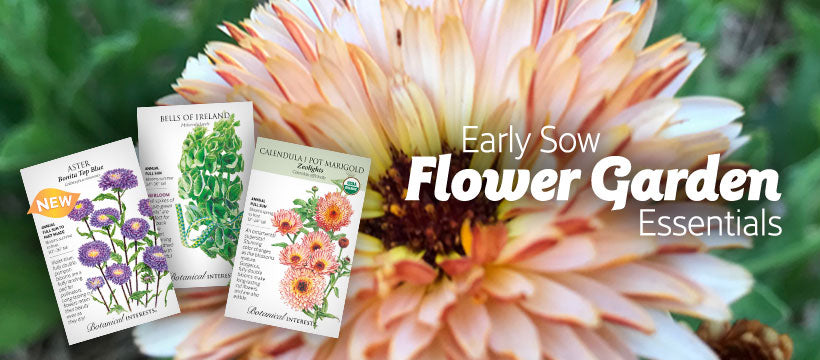What's so great about spinach? It's highly nutritious, quick to harvest, and is even able to overwinter in many climates--even with sub-zero temperatures! The key to growing great spinach is growing it during cool weather and paying attention to soil temperatures. In most areas, spinach is grown in the cool temperatures of spring and fall, and in mild-winter climates it can be grown from fall through winter. Successively sow spinach for a seemingly endless supply for your favorite seasonal recipes, from a summer spinach salad to a holiday creamed spinach side dish. If you were wondering how to grow spinach from seed, you've come to the right place!

GENERAL SOWING
When to Sow Outside: 4 to 6 weeks before your average last frost date, and when soil temperature is above 40°F; ideally 50°���75°F. Successive Sowings: Every 3 weeks until 4 weeks before your average first fall frost date. If mulched, spinach can overwinter in sub-zero temperatures. Soil temperatures above 85°F halt germination. Mild Climates: Sow in fall for cool-season harvests.
When to Start Inside: Not recommended; roots sensitive to disturbance and transplanting can cause bolting (flowering).
How many do I plant? Spinach yields near to a ½ lb. per row foot (linear foot/single row; not square foot). That means a 10-foot row will yield about 4 lbs. Plan your succession sowing accordingly.
OUTDOOR SOWING
Sowing preparation and spacing
Choose an area in full sun (6 or more hours) or part shade (4 to 6 hours). In the heat of summer, afternoon shade can help cool your spinach crop which can prolong the harvest. If needed, prep the soil so it is rich in organic matter, light, and well drained. Sow ½" deep at the spacing suggested by the packet instructions. If growing for baby greens, you can sow as close as 1" apart.
Soil Temperature
Spinach germinates best in cool soil (50°F-75°F ) and grows with ease in the cool temperatures of spring and fall.
Thinning
For mature-sized plants, thin when 1" tall to the recommended spacing on the seed packet. For baby greens, no thinning is required.
Water
Spinach is 96% water and has shallow roots, so it is important to keep the sown area and seedlings consistently moist but not soggy.
Fertilization
Fertilize regularly with a water-soluble, balanced (equal parts nitrogen, phosphorus, and potassium), or nitrogen-rich fertilizer if foliage is chlorotic (yellow). Use light applications since spinach is sensitive to too much nitrogen.
Weeding
Keep plants well weeded. Weeds compete with crops for light, nutrients, and water, and can harbor insects and diseases.
Special care
Spinach seeds experience heat dormancy in warm conditions (near 85°F) and will fail to germinate or germinate poorly. You can cool the planting area by shading it with boards elevated a few inches above the soil and sow heavier (more seeds per group) to help compensate for lower germination due to heat. Seeds can also be pre-sprouted in the refrigerator between wet paper towels in a sealed container. Plant sprouted seeds in the garden or growing container as soon as you notice a root emerge.

HARVESTING
One sowing of spinach can typically be harvested multiple times (about 3 times) and should be harvested frequently (weekly or more often) for most production. Pick individual leaves from outer edges of plant as they become big enough to use or cut the whole plant 1" above the ground; new leaves will be produced. When picking individual leaves, also removing the leaf stem at the same time is best; this reduces vulnerability to disease during die-back and conserves plant energy. Harvest before the plant sends up a flower stalk (bolting). Just prior to bolting, leaves take on an "arrowhead" shape, adding small keel shapes to the base of the leaf. Due to crowding, spinach sown at the baby green spacing will bolt more quickly than seeds sown at the full-sized plant spacing.
STORAGE
FRESH: Spinach should be dry for storage; either rinse in cold water and dry, or wait to wash until just before preparing. Store in a sealed container in the vegetable drawer of the refrigerator for up to 2 weeks. FROZEN: Wash, blanch, and drain leaves, then place in a freezer-safe container.
COMMON PESTS AND DISEASES
Leafminer damage appears as winding trails and light-colored blotches in leaf tissue. Remove and dispose of infested leaves (do not compost). Floating row covers may help to screen out the fly that lays the eggs on the leaves.
Aphids are among the most common and troublesome garden pests. They feed by sucking plant sap, which causes distorted leaves, buds, and flowers, and sometimes spread plant viruses in the process. Aphids excrete a sticky honeydew that attracts ants, and is a host for black sooty mold. Knock aphids off plants with a strong stream of water; repeat frequently as needed. There are many native predators and parasites that can control aphids; attract them by planting pollen and nectar plants. For heavy outbreaks, spray insecticidal soap, neem (an extract of the tropical tree, Azadirachta indica), or homemade oil sprays. Oil sprays work by smothering the insects and mites they come in contact with; thus, thorough coverage is important. Garlic Oil Spray: Soak 3 oz. of finely minced, fresh garlic in 2 tsp. of mineral oil for at least 24 hours. Add 1 pint of water and 1 tsp. of liquid dish soap. Stir well and strain into a glass jar for storage. Mix 1-2 tbsp. of this concentrate with 1 pint of water to make a spray. Test your mixture on a few leaves to check for possible injury caused by the oil and soap. If there is no sign of leaf damage after a day or two, it is safe to use. Spray plants thoroughly for good coverage.


